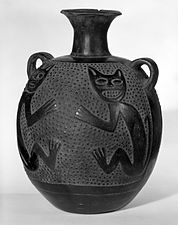- Учителю
- Научная работа на тему All about cats (2 класс)
Научная работа на тему All about cats (2 класс)
All about cats
The domestic cat or the feral cat (Latin: Felis silvestris catus) is a small, typically furry, carnivorous mammal. They are often called house cats when kept as indoor pets or simply cats when there is no need to distinguish them from other felids and felines. Cats are often valued by humans for companionship and for their ability to hunt vermin. There are more than 70 cat breeds; different associations proclaim different numbers according to their standards.
Cats are similar in anatomy to the other felids, with a strong, flexible body, quick reflexes, sharp retractable claws, and teeth adapted to killing small prey. Cat senses fit a crepuscular and predatory ecological niche. Cats can hear sounds too faint or too high in frequency for human ears, such as those made by mice and other small animals. They can see in near darkness. Like most other mammals, cats have poorer color vision and a better sense of smell than humans. Cats, despite being solitary hunters, are a social species and cat communication includes the use of a variety of vocalizations (mewing, purring, trilling, hissing, growling, and grunting), as well as cat pheromones and types of cat-specific body language.
Cats have a high breeding rate. Under controlled breeding, they can be bred and shown as registered pedigree pets, a hobby known as cat fancy. Failure to control the breeding of pet cats by neutering and the abandonment of former household pets has resulted in large numbers of feral cats worldwide, requiring population control. This has contributed, along with habitat destruction and other factors, to the extinction of many bird species. Cats have been known to extirpate a bird species within specific regions and may have contributed to the extinction of isolated island populations. Cats are thought to be primarily, though not solely, responsible for the extinction of 33 species of birds, and the presence of feral and free ranging cats makes some locations unsuitable for attempted species reintroduction in otherwise suitable locations.
Since cats were venerated in ancient Egypt, they were commonly believed to have been domesticated there, but there may have been instances of domestication as early as the Neolithic from around 9,500 years ago (7,500 BCE). A genetic study in 2007 concluded that domestic cats are descended from Near Eastern wildcats, having diverged around 8,000 BCE in West Asia. A 2016 study found that leopard cats were undergoing domestication independently in China around 5,500 BCE, though this line of partially domesticated cats leaves no trace in the domesticated populations of today.
Taxonomy and evolution
Main article: Cat evolution
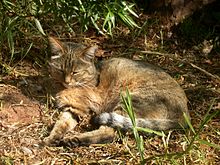
The African wildcat, Felis silvestris lybica, is the ancestor of the domestic cat.
The felids are a rapidly evolving family of mammals that share a common ancestor only 10-15 million years ago and include lions, tigers, cougars and many others. Within this family, domestic cats (Felis catus) are part of the genus Felis, which is a group of small cats containing about seven species (depending upon classification scheme). Members of the genus are found worldwide and include the jungle cat (Felis chaus) of southeast Asia, European wildcat (F. silvestris silvestris), African wildcat (F. s. lybica), the Chinese mountain cat (F. bieti), and the Arabian sand cat (F. margarita), among others.
The domestic cat was first classified as Felis catus by Carl Linnaeus in the 10th edition of his Systema Naturae published in 1758. Because of modern phylogenetics, domestic cats are usually regarded as another subspecies of the wildcat, F. silvestris. This has resulted in mixed usage of the terms, as the domestic cat can be called by its subspecies name, Felis silvestris catus. Wildcats have also been referred to as various subspecies of F. catus, but in 2003, the International Commission on Zoological Nomenclature fixed the name for wildcats as F. silvestris. The most common name in use for the domestic cat remains F. catus, following a convention for domesticated animals of using the earliest (the senior) synonym proposed. Sometimes, the domestic cat has been called Felis domesticus or Felis domestica, as proposed by German naturalist J. C. P. Erxleben in 1777 but these are not valid taxonomic names and have been used only rarely in scientific literature, because Linnaeus's binomial takes precedence. A population of Transcaucasia black feral cats was once classified as Felis daemon (Satunin 1904) but now this population is considered to be a part of domestic cat.
All the cats in this genus share a common ancestor that probably lived around 6-7 million years ago in Asia. The exact relationships within the Felidae are close but still uncertain, e.g. the Chinese mountain cat is sometimes classified (under the name Felis silvestris bieti) as a subspecies of the wildcat, like the North African variety F. s. lybica.
In comparison to dogs, cats have not undergone major changes during the domestication process, as the form and behavior of the domestic cat is not radically different from those of wildcats and domestic cats are perfectly capable of surviving in the wild. Fully domesticated house cats often interbreed with feral F. catus populations. This limited evolution during domestication means that hybridisation can occur with many other felids, notably the Asian leopard cat. Several natural behaviors and characteristics of wildcats may have preadapted them for domestication as pets. These traits include their small size, social nature, obvious body language, love of play and relatively high intelligence. Several small felid species may have an inborn tendency towards tameness.
Cats have either a mutualistic or commensal relationship with humans. Two main theories are given about how cats were domesticated. In one, people deliberately tamed cats in a process of artificial selection, as they were useful predators of vermin. This has been criticized as implausible, because the reward for such an effort may have been too little; cats generally do not carry out commands and although they do eat rodents, other species such as ferrets or terriers may be better at controlling these pests. The alternative idea is that cats were simply tolerated by people and gradually diverged from their wild relatives through natural selection, as they adapted to hunting the vermin found around humans in towns and villages.
Anatomy
Diagram of the general anatomy of a male
Domestic cats are similar in size to the other members of the genusFelis, typically weighing between 4 and 5 kg (9 and 10 lb). Somebreeds, however, such as the Maine Coon, can occasionally exceed 11 kg (24 lb). Conversely, very small cats, less than 2 kg (4 lb), have been reported.The world record for the largest cat is 21 kg (50 lb). The smallest adult cat ever officially recorded weighed around 1 kg (2 lb). Feral cats tend to be lighter as they have more limited access to food than house cats. In the Bostonarea, the average feral adult male will weigh 4 kg (9 lb) and average feral female 3 kg (7 lb). Cats average about 23-25 cm (9-10 in) in height and 46 cm (18 in) in head/body length (males being larger than females), with tails averaging 30 cm (12 in) in length.
Cats have seven cervical vertebrae, as do almost all mammals; 13 thoracic vertebrae (humans have 12); seven lumbar vertebrae (humans have five); three sacral vertebrae like most mammals (humans have five); and a variable number of caudal vertebrae in the tail (humans retain three to five caudal vertebrae, fused into an internal coccyx). The extra lumbar and thoracic vertebrae account for the cat's spinal mobility and flexibility. Attached to the spine are 13 ribs, the shoulder, and thepelvis. Unlike human arms, cat forelimbs are attached to the shoulder by free-floating clavicle bones which allow them to pass their body through any space into which they can fit their head.
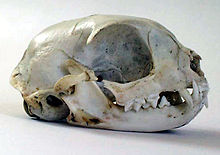
Cat skull
The cat skull is unusual among mammals in having very large eye sockets and a powerful and specialized jaw. Within the jaw, cats have teeth adapted for killing prey and tearing meat. When it overpowers its prey, a cat delivers a lethal neck bite with its two long canine teeth, inserting them between two of the prey's vertebrae and severing its spinal cord, causing irreversible paralysis and death. Compared to other felines, domestic cats have narrowly spaced canine teeth, which is an adaptation to their preferred prey of small rodents, which have small vertebrae. The premolar and firstmolar together compose the carnassial pair on each side of the mouth, which efficiently shears meat into small pieces, like a pair of scissors. These are vital in feeding, since cats' small molars cannot chew food effectively, and cats are largely incapable of mastication. Though cats tend to have better teeth than most humans, with decay generally less likely because of a thicker protective layer of enamel, a less damaging saliva, less retention of food particles between teeth, and a diet mostly devoid of sugar, they are nonetheless subject to occasional tooth loss and infection.
Cats, like dogs, are digitigrades. They walk directly on their toes, with the bones of their feet making up the lower part of the visible leg. Cats are capable of walking very precisely, because like all felines, they directly register; that is, they place each hind paw (almost) directly in the print of the corresponding fore paw, minimizing noise and visible tracks. This also provides sure footing for their hind paws when they navigate rough terrain. Unlike most mammals, when cats walk, they use a "pacing" gait; that is, they move the two legs on one side of the body before the legs on the other side. This trait is shared with camels andgiraffes. As a walk speeds up into a trot, a cat's gait changes to be a "diagonal" gait, similar to that of most other mammals (and many other land animals, such as lizards): the diagonally opposite hind and fore legs move simultaneously.
Like almost all members of the Felidae, cats have protractable and retractable claws. In their normal, relaxed position, the claws are sheathed with the skin and fur around the paw's toe pads. This keeps the claws sharp by preventing wear from contact with the ground and allows the silent stalking of prey. The claws on the fore feet are typically sharper than those on the hind feet. Cats can voluntarily extend their claws on one or more paws. They may extend their claws in hunting or self-defense, climbing, kneading, or for extra traction on soft surfaces. Most cats have five claws on their front paws, and four on their rear paws. The fifth front claw (the dewclaw) is proximal to the other claws. More proximally is a protrusion which appears to be a sixth "finger". This special feature of the front paws, on the inside of the wrists, is the carpal pad, also found on the paws of big cats and dogs. It has no function in normal walking, but is thought to be an antiskidding device used while jumping. Some breeds of cats are prone to polydactyly (extra toes and claws). These are particularly common along the northeast coast of North America.
Senses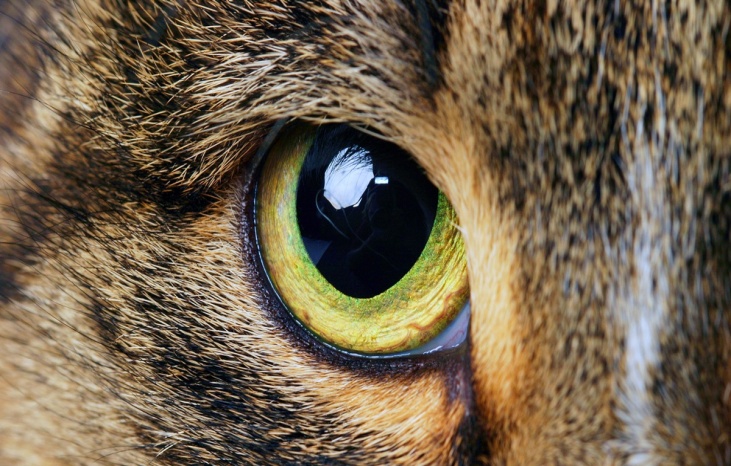
A closeup of a cat's eye
Main article: Cat senses
Reflection of camera flash from thetapetum lucidum
Cats have excellent night vision and can see at only one-sixth the light level required for human vision. This is partly the result of cat eyes having a tapetum lucidum, which reflects any light that passes through the retina back into the eye, thereby increasing the eye's sensitivity to dim light. Another adaptation to dim light is the large pupils of cats' eyes. Unlike some big cats, such as tigers, domestic cats have slit pupils. These slit pupils can focus bright light without chromatic aberration, and are needed since the domestic cat's pupils are much larger, relative to their eyes, than the pupils of the big cats. At low light levels a cat's pupils will expand to cover most of the exposed surface of its eyes. However, domestic cats have rather poor color vision and (like most nonprimate mammals) have only two types of cones, optimized for sensitivity to blue and yellowish green; they have limited ability to distinguish between red and green. A 1993 paper reported a response to middle wavelengths from a system other than the rods which might be due to a third type of cone. However, this appears to be an adaptation to low light levels rather than representing true trichromatic vision.
Cats have excellent hearing and can detect an extremely broad range of frequencies. They can hear higher-pitched sounds than either dogs or humans, detecting frequencies from 55 Hz to 79,000 Hz, a range of 10.5 octaves, while humans and dogs both have ranges of about 9 octaves. Cats can hear ultrasound, which is important in hunting because many species of rodents make ultrasonic calls. However, they do not communicate using ultrasound like rodents do. Cats' hearing is also sensitive and among the best of any mammal, being most acute in the range of 500 Hz to 32 kHz. This sensitivity is further enhanced by the cat's large movable outer ears (their pinnae), which both amplify sounds and help detect the direction of a noise.[81]

Cats' whiskers are highly sensitive to touch.
Cats have an acute sense of smell, due in part to their well-developed olfactory bulb and a large surface of olfactory mucosa, about 5.8 cm2 (0.90 in2) in area, which is about twice that of humans. Cats are sensitive to pheromones such as 3-mercapto-3-methylbutan-1-ol, which they use to communicate through urine spraying and marking with scent glands. Many cats also respond strongly to plants that containnepetalactone, especially catnip, as they can detect that substance at less than one part per billion. About 70-80% of cats are affected by nepetalactone. This response is also produced by other plants, such as silver vine (Actinidia polygama) and the herbvalerian; it may be caused by the smell of these plants mimicking a pheromone and stimulating cats' social or sexual behaviors.
Cats have relatively few taste buds compared to humans (470 or so versus more than 9,000 on the human tongue). Domestic and wild cats share a gene mutation that keeps their sweet taste buds from binding to sugary molecules, leaving them with no ability to taste sweetness. Their taste buds instead respond to amino acids, bitter tastes, and acids. Cats and many other animals have a Jacobson's organ located in their mouths that allows them to taste-smell certain aromas in a way which humans have no experience of. Cats also have a distinct temperature preference for their food, preferring food with a temperature around 100 °F (38 °C) which is similar to that of a fresh kill and routinely rejecting food presented cold or refrigerated (which would signal to the cat that the "prey" item is long dead and therefore possibly toxic/ decomposing).
To aid with navigation and sensation, cats have dozens of movable whiskers (vibrissae) over their body, especially their faces. These provide information on the width of gaps and on the location of objects in the dark, both by touching objects directly and by sensing air currents; they also trigger protective blink reflexes to protect the eyes from damage.
Most breeds of cat have a noted fondness for settling in high places, or perching. In the wild, a higher place may serve as a concealed site from which to hunt; domestic cats may strike prey by pouncing from a perch such as a tree branch, as does aleopard. Another possible explanation is that height gives the cat a better observation point, allowing it to survey its territory. During a fall from a high place, a cat can reflexively twist its body and right itself using its acute sense of balance and flexibility. This is known as the cat righting reflex. An individual cat always rights itself in the same way, provided it has the time to do so, during a fall. The height required for this to occur is around 90 cm (3.0 ft). Cats without a tail (e.g. Manx cats) also have this ability, since a cat mostly moves its hind legs and relies on conservation of angular momentum to set up for landing, and the tail is little used for this feat.
Behavior
See also: Cat behavior and Cat intelligence
Outdoor cats are active both day and night, although they tend to be slightly more active at night. The timing of cats' activity is quite flexible and varied, which means house cats may be more active in the morning and evening, as a response to greater human activity at these times. Although they spend the majority of their time in the vicinity of their home, housecats can range many hundreds of meters from this central point, and are known to establish territories that vary considerably in size, in one study ranging from 7 to 28 hectares (17-69 acres).
Cats conserve energy by sleeping more than most animals, especially as they grow older. The daily duration of sleep varies, usually between 12 and 16 hours, with 13 and 14 being the average. Some cats can sleep as much as 20 hours. The term "cat nap" for a short rest refers to the cat's tendency to fall asleep (lightly) for a brief period. While asleep, cats experience short periods of rapid eye movement sleep often accompanied by muscle twitches, which suggests they are dreaming.
Sociability
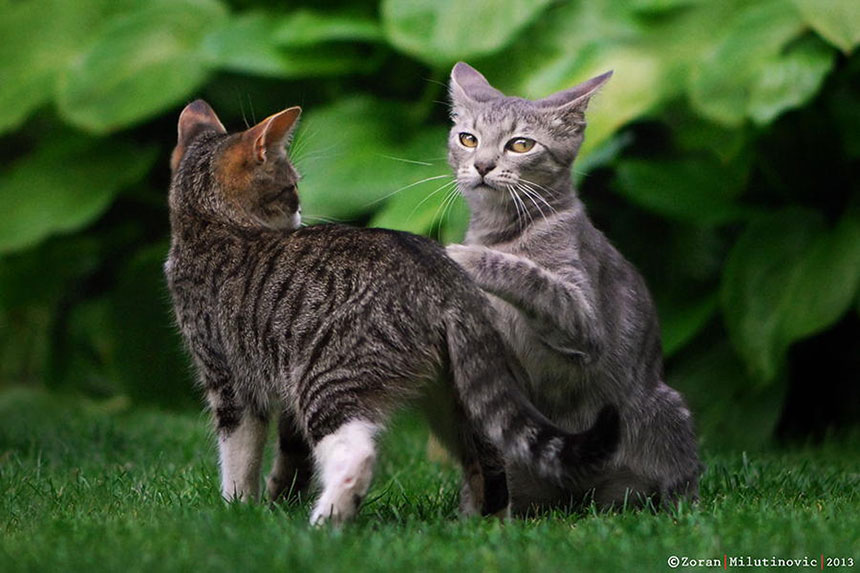
Social grooming
Although wildcats are solitary, the social behavior of domestic cats is much more variable and ranges from widely dispersed individuals to feral cat colonies that form around a food source, based on groups of co-operating females. Within such groups, one cat is usually dominant over the others. Each cat in a colony holds a distinct territory, with sexually active males having the largest territories, which are about 10 times larger than those of female cats and may overlap with several females' territories. These territories are marked by urine spraying, by rubbing objects at head height with secretions from facial glands, and by defecation. Between these territories are neutral areas where cats watch and greet one another without territorial conflicts. Outside these neutral areas, territory holders usually chase away stranger cats, at first by staring, hissing, and growling, and if that does not work, by short but noisy and violent attacks. Despite some cats cohabiting in colonies, they do not have a social survival strategy, or a pack mentality, and always hunt alone.
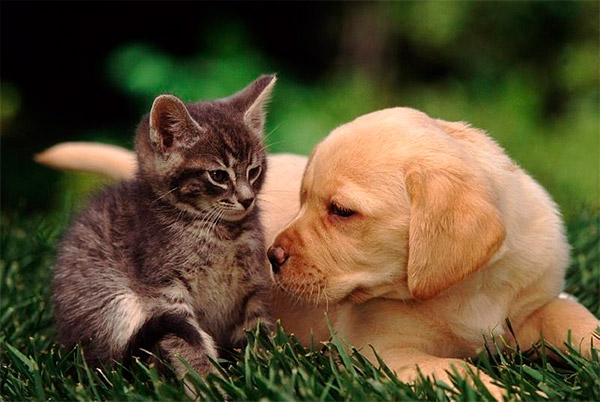
Cat with an Alaskan Malamute dog
However, some pet cats are poorly socialized. In particular, older cats may show aggressiveness towards newly arrived kittens, which may include biting and scratching; this type of behavior is known as feline asocial aggression.
Though cats and dogs are believed to be natural enemies, they can live together if correctly socialized.
Life in proximity to humans and other domestic animals has led to a symbiotic social adaptation in cats, and cats may express great affection toward humans or other animals. Ethologically, the human keeper of a cat may function as a sort of surrogate for the cat's mother, and adult housecats live their lives in a kind of extended kittenhood, a form of behavioral neoteny. The high-pitched sounds housecats make to solicit food may mimic the cries of a hungry human infant, making them particularly hard for humans to ignore.
Communication
Main article: Cat communication
Domestic cats use many vocalizations for communication, including purring, trilling, hissing, growling/snarling, grunting, and several different forms of meowing. By contrast, feral cats are generally silent. Their types of body language, including position of ears and tail, relaxation of the whole body, and kneading of the paws, are all indicators of mood. The tail and ears are particularly important social signal mechanisms in cats; for example, a raised tail acts as a friendly greeting, and flattened ears indicates hostility. Tail-raising also indicates the cat's position in the group's social hierarchy, with dominant individuals raising their tails less often than subordinate animals. Nose-to-nose touching is also a common greeting and may be followed by social grooming, which is solicited by one of the cats raising and tilting its head.
Purring may have developed as an evolutionary advantage as a signalling mechanism of reassurance between mother cats andnursing kittens. Post-nursing cats often purr as a sign of contentment: when being petted, becoming relaxed, or eating. The mechanism by which cats purr is elusive. The cat has no unique anatomical feature that is clearly responsible for the sound. It was, until recent times, believed that only the cats of the Felis genus could purr. However, felids of the Pantheragenus (tiger, lion, jaguar, and leopard) also produce sounds similar to purring, but only when exhaling.
Grooming

The hooked papillae on a cat's tongue act like a hairbrush to help clean and detangle fur.
Cats are known for spending considerable amounts of time licking their coat to keep it clean. The cat's tongue has backwards-facing spines about 500 μm long, which are called papillae. These contain keratin which makes them rigid so the papillae act like a hairbrush. Some cats, particularly longhaired cats, occasionally regurgitate hairballs of fur that have collected in their stomachs from grooming. These clumps of fur are usually sausage-shaped and about 2-3 cm (0.8-1.2 in) long. Hairballs can be prevented with remedies that ease elimination of the hair through the gut, as well as regular grooming of the coat with a comb or stiff brush. Some cats can develop a compulsive behavior known as psychogenic alopecia, or excessive grooming.
Hunting and feeding
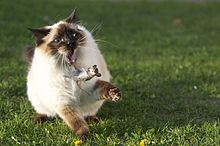
A cat that is playing with a caught mouse. Cats play with their prey to weaken or exhaust them before making a kill.
Cats hunt small prey, primarily birds and rodents,
and are often used as a form of pest control.
Domestic cats are a major predator of wildlife in the United States, killing an estimated 1.4-3.7 billion birds and 6.9-20.7 billion mammals annually.The bulk of predation in the United States is done by 80 million feral and stray cats. Effective measures to reduce this population are elusive, meeting opposition from cat enthusiasts. In the case of free-ranging pets, equipping cats with bells and not letting them out at night will reduce wildlife predation.
Free-fed feral cats and house cats tend to consume many small meals in a single day, although the frequency and size of meals varies between individuals.[132] Cats use two hunting strategies, either stalking prey actively, or waiting in ambush until an animal comes close enough to be captured. Although it is not certain, the strategy used may depend on the prey species in the area, with cats waiting in ambush outside burrows, but tending to actively stalk birds.
Perhaps the best known element of cats' hunting behavior, which is commonly misunderstood and often appalls cat owners because it looks like torture, is that cats often appear to "play" with prey by releasing it after capture. This behavior is due to an instinctive imperative to ensure that the prey is weak enough to be killed without endangering the cat. This behavior is referred to in the idiom "cat-and-mouse game" or simply "cat and mouse".
Another poorly understood element of cat hunting behavior is the presentation of prey to human guardians. Ethologist Paul Leyhausen proposed that cats adopt humans into their social group and share excess kill with others in the group according to the dominance hierarchy, in which humans are reacted to as if they are at, or near, the top. Anthropologist and zoologistDesmond Morris, in his 1986 book Catwatching, suggests, when cats bring home mice or birds, they are attempting to teach their human to hunt, or trying to help their human as if feeding "an elderly cat, or an inept kitten".Morris's theory is inconsistent with the fact that male cats also bring home prey, despite males having no involvement with raising kittens.
Domestic cats select food based on its temperature, smell and texture; they dislike chilled foods and respond most strongly to moist foods rich in amino acids, which are similar to meat. Cats may reject novel flavors (a response termed neophobia) and learn quickly to avoid foods that have tasted unpleasant in the past. They may also avoid sugary foods and milk. Most adult cats are lactose intolerant; the sugars in milk are not easily digested and may cause soft stools or diarrhea. They can also develop odd eating habits. Some cats like to eat or chew on other things, most commonly wool, but also plastic, cables, paper, string, aluminum foil, or even coal. This condition, pica, can threaten their health, depending on the amount and toxicity of the items eaten.
Though cats usually prey on animals less than half their size, a feral cat in Australia has been photographed killing an adult pademelon weighing around the cat's size at 4 kg (8.8 lb).
Since cats cannot fully close their lips around something to create suction, they use a lapping method with the tongue to draw liquid upwards into their mouths. Lapping at a rate of four times a second, the cat touches the smooth tip of its tongue to the surface of the water, and quickly retracts it, drawing water upwards.
Play
Main article: Cat play and toys

Play fight between kittens, age 14 weeks
Domestic cats, especially young kittens, are known for their love of play. This behavior mimics hunting and is important in helping kittens learn to stalk, capture, and killprey. Cats also engage in play fighting, with each other and with humans. This behavior may be a way for cats to practice the skills needed for real combat, and might also reduce any fear they associate with launching attacks on other animals.
Owing to the close similarity between play and hunting, cats prefer to play with objects that resemble prey, such as small furry toys that move rapidly, but rapidly lose interest (they become habituated) in a toy they have played with before. Cats also tend to play with toys more when they are hungry. String is often used as a toy, but if it is eaten, it can become caught at the base of the cat's tongue and then move into the intestines, a medical emergency which can cause serious illness, even death. Owing to the risks posed by cats eating string, it is sometimes replaced with a laser pointer's dot, which cats may chase. There are several important issues related to using a laser with a cat; first most, lasers can cause blindness in cats, even lasers which are sold as "eye safe" can actually be of much higher power of that proclaimed and can cause damages to the eyes. In addition, the cat thinks of the laser point as prey, but gets frustrated as he is unable to catch it.
History and mythology
Main articles: Cultural depictions of cats and Cats in ancient Egypt

A 19th century drawing of a tabby cat
Traditionally, historians tended to think ancient Egypt was the site of cat domestication, owing to the clear depictions of house cats in Egyptian paintings about 3,600 years old. However, in 2004, a Neolithic grave excavated in Shillourokambos, Cyprus, contained the skeletons, laid close to one another, of both a human and a cat. The grave is estimated to be 9,500 years old, pushing back the earliest known feline-human association significantly. The cat specimen is large and closely resembles the African wildcat, rather than present-day domestic cats. This discovery, combined with genetic studies, suggests cats were probably domesticated in the Middle East, in theFertile Crescent around the time of the development of agriculture and then they were brought to Cyprus and Egypt.
Direct evidence for the domestication of cats 5,300 years ago in Quanhucun, China has been published by archaeologists and paleontologists from the University of Washington and Chinese Academy of Sciences. The cats are believed to have been attracted to the village by rodents, which in turn were attracted by grain cultivated and stored by humans.
In ancient Egypt, cats were sacred animals, with the goddess Bastet often depicted in cat form, sometimes taking on the war-like aspect of a lioness. The Romans are often credited with introducing the domestic cat from Egypt to Europe; inRoman Aquitaine, a first- or second-century engraving of a young girl holding a cat is one of two earliest depictions of the Roman domesticated cat. However, cats possibly were already kept in Europe prior to the Roman Empire, as they may have been present in Britain in the late Iron Age. Domestic cats were spread throughout much of the rest of the world during the Age of Discovery, as they were carried on sailing ships to control shipboard rodents and as good-luck charms (see Ship's cat).
Several ancient religions believed cats are exalted souls, companions or guides for humans, that are all-knowing but mute so they cannot influence decisions made by humans. In Japan, the maneki neko cat is a symbol of good fortune.
Although no species are sacred in Islam, cats are revered by Muslims. Some Western writers have stated Muhammad had a favorite cat, Muezza. He is reported to have loved cats so much, "he would do without his cloak rather than disturb one that was sleeping on it". The story has no origin in early Muslim writers, and seems to confuse a story of a later Sufi saint,Ahmed ar-Rifa'i, centuries after Muhammad.
Freyja, the goddess of love, beauty, and fertility in Norse mythology, is depicted as riding a chariot drawn by cats.
Many cultures have negative superstitions about cats. An example would be the belief that a black cat "crossing one's path" leads to bad luck, or that cats are witches' familiars used to augment a witch's powers and skills. The killing of cats in MedievalYpres, Belgium, is commemorated in the innocuous present-day Kattenstoet (cat parade).
According to a myth in many cultures, cats have multiple lives. In many countries, they are believed to have nine lives, but in Italy, Germany, Greece, Brazil and some Spanish-speaking regions, they are said to have seven lives, while in Turkish and Arabic traditions, the number of lives is six. The myth is attributed to the natural suppleness and swiftness cats exhibit to escape life-threatening situations. Also lending credence to this myth is the fact that falling cats often land on their feet, using an instinctive righting reflex to twist their bodies around. Nonetheless, cats can still be injured or killed by a high fall.
Depictions of cats in art
Jar with Small Looped Handles and Feline Design, Chimú c. 1100-1400. Brooklyn Museum
Figure of a Cat made by Meissen Porcelain Factory, Saxony c. 1800. Brooklyn Museum
Cats from Unai no tomo by Shimizu Seifu. Japan, 1891-1923. Brooklyn Museum
Pair of Cat Bookends manufactured by Chase Brass & Copper Co., USA c. 1930-1935.Brooklyn Museum
Cat illustration by the German artist Fedor Flinzer, called Raphael of Cats</<font color="#252525">.
